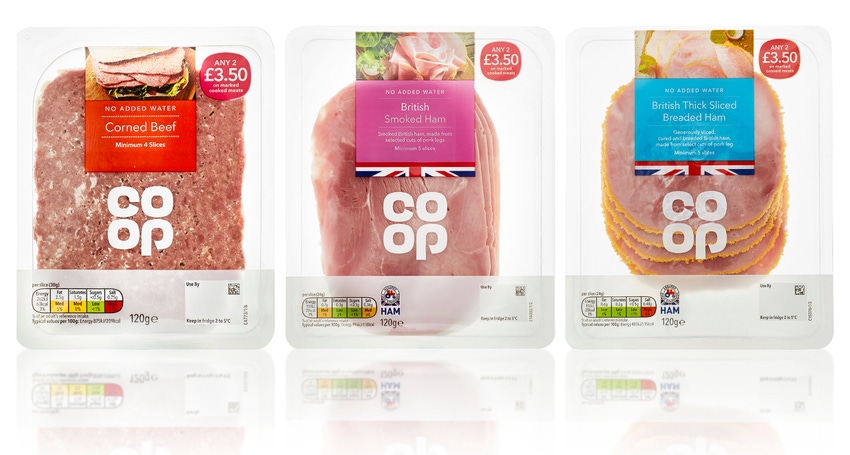U.K. retailer develops recyclable trays for private-label meats

Sustainable packaging is a key goal for the Co-op, a food retailer in the United Kingdom. The company has committed to making 80% of its private-label packaging recyclable within the next three years. Toward that end, Co-op has partnered with packaging supplier Coveris and meat supplier Tulip Ltd to create recyclable food packaging for two lines of cooked meats.
A new multilayer lidding film that eliminates the need for a sealing layer (liner) in PET trays is fundamental to the new packaging design. The thin, easy-peel lidding film includes a polyester-based sealant layer that enables heat sealing of lidding directly to mono PET trays. The new tray is not lined with polyethylene, rendering the mono PET tray more easily recyclable than conventional lined PET trays.
The retailer uses the new packaging for its Co-op and Irresistible Co-op private-label lines of cooked meats. Tulip, the United Kingdom’s largest producer of pork, supplies and packs the products.
Will Mercer, group research and development director with Coveris in the United Kingdom, provides additional insight into the characteristics and capabilities of Co-op’s recyclable packaging.
When did Co-op introduce the recyclable meat packaging in its stores?
Mercer: The launch of the new film was of significant size and scale over a five-month period, completing in January 2017. The film has currently only been launched on the Co-op cooked meat range.
What is the structure of the lidding film?
Mercer: The structure is a 12-µm [microns] polyester film laminated to a nine-layer coextruded structure designed to seal and peel from mono PET.
How thick is the lidding film?
Mercer: 63.5 microns, final composition.
Does the new lidding film work with tray materials besides mono PET?
Mercer: Subject to testing, the film should seal to CPET [crystallized polyethylene terephthalate]; however, it is not designed to seal to standard polythene [a.k.a. polyethylene] grades.
What is the barrier performance of the new film?
Mercer: DIN 53122 < 2g/m²/24 hours; DIN 53380 < 1cm³/m²/24 hours
How much shelf life does the package provide for Co-op’s cooked meat products?
Mercer: The customer’s current shelf-life expectation is a maximum of 28 days.
How is the film designed for easy peeling while ensuring that the seals won’t burst in transit or storage?
Mercer: The film is designed to weld-seal directly to the mono polyester base web. Through polymer engineering, the adhesion level between the seal layer and the tie layer is optimized to allow sufficient peel strength to enable easy opening, and [make the seals] strong enough to withstand supply chain demands.
How does the cost of the new film compare with the typical lidding used for meat-tray applications? Are there any savings in the tray to offset any additional costs in the lidding film?
Mercer: Savings gained by using a non-polythene-lined tray are used to offset the increased cost of the higher-performance coextruded lidding film. However, specific cost information is based on several factors, including volume and print requirements.
How likely is it that the mono PET trays used with the new film will be recycled?
Mercer: Based on feedback from U.K.-based recycling companies, the answer is highly likely, due to their advanced sorting systems.
What messaging will be on the package to let consumers know to recycle the tray?
Mercer: An on-pack message alerts the consumer to the suitability for recycling.
How will recyclers know this tray is recyclable?
Mercer: Advanced infrared scanning of materials identifies the material and streams it to the right recycling area.
What other applications can this new packaging solution be used for, in addition to meat?
Mercer: In theory, the film can be used for many other applications, but it is not suitable for ovenable products.
How many sizes does the new Co-op meat packaging come in?
Mercer: Currently there are five profiles. However, there is no limitation on this.
**************************************************************************************************
This fall, boost your packaging expertise and discover more solutions by attending MinnPack 2017 (Nov. 8-9; Minneapolis), the largest Advanced Design & Manufacturing Event in the Midwest. Register today!
About the Author(s)
You May Also Like




